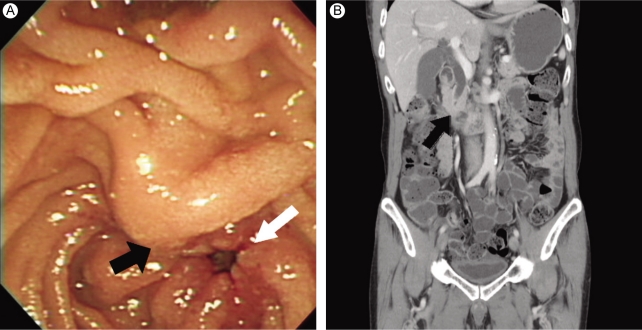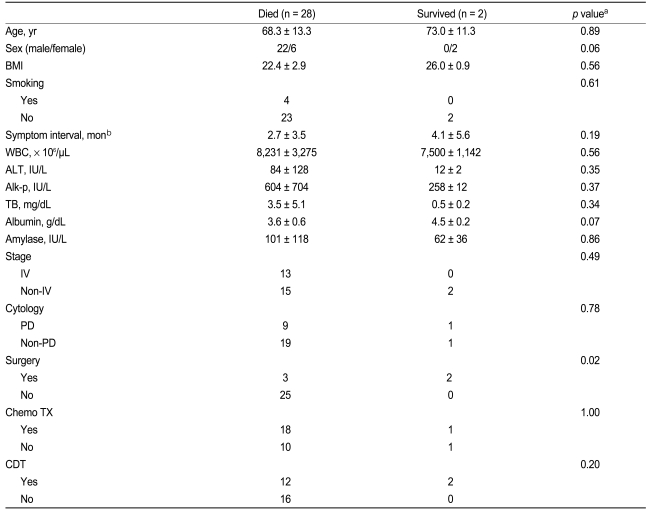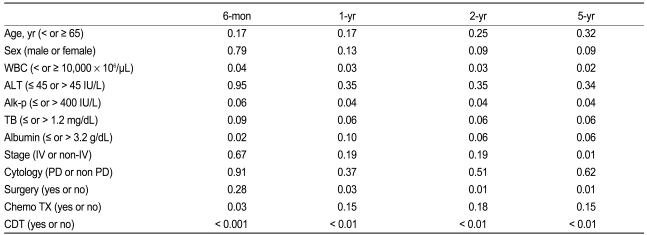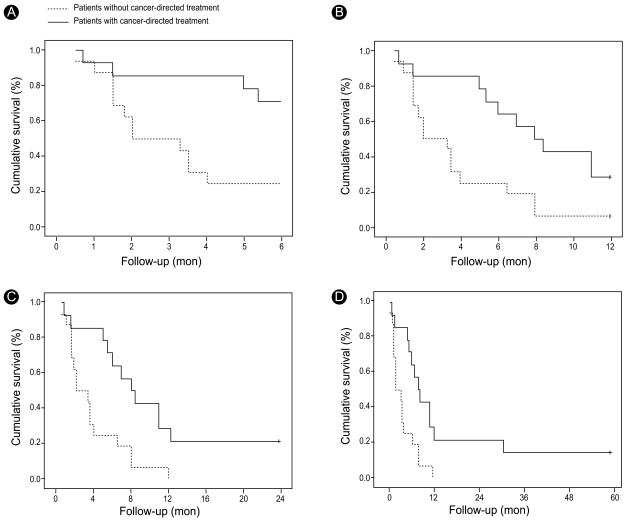Abstract
Background/Aims
The prognostic factors in primary duodenal adenocarcinoma remain controversial. This study evaluated the prognostic factors associated with survival in patients with primary duodenal adenocarcinoma.
Methods
From March 1996 to June 2008, the medical records of 30 patients with a final diagnosis of primary duodenal epithelial malignancy seen at two referral centers were reviewed retrospectively. The prognostic factors for survival were evaluated 6 months and 1, 2, and 5 years after the diagnosis.
Results
The median survival was 5.7 months. The survival rate was 46.7% (14/30), 16.7% (5/30), 10% (3/30), and 6.7% (2/30) at 6 months and 1, 2, and 5 years, respectively. Multivariate analysis showed that cancer-directed treatment, including curative surgery or chemotherapy, was a common independent risk factor at all follow-up times. Total bilirubin, cytology, and TNM stage were independent risk factors for survival at 1, 2, and 5 years. The white blood cell count was an independent risk factor at 1 year only. The actuarial probability of survival in patients undergoing cancer-directed treatment was significantly higher than in those without treatment at 6 months (71.4 vs. 25.0%, p < 0.01), 1 year (28.6 vs. 6.3%, p < 0.01), 2 years (21.4 vs. 0%, p < 0.01), and 5 years (14.3 vs. 0%, p < 0.01).
Conclusions
The prognostic factors in patients with primary duodenal adenocarcinoma were total bilirubin, TNM stage, cytology, and cancer-directed treatments until the 5-year follow-up. Especially, cancer-directed treatments improved patient survival.
Keywords: Duodenal cacner, Prognosis, Cancer-directed treatment
INTRODUCTION
Primary duodenal adenocarcinoma is a rare malignant neoplasm; it accounts for 0.3% of all gastrointestinal tract carcinomas and 33-45% of all small-intestine carcinomas [1-5]. Its poor prognosis is likely associated in part with the frequently delayed diagnosis, which results from the difficulty making a diagnosis, as patients often present with non-specific symptoms or signs not suggesting the need for upper gastrointestinal endoscopy [6-8]. Due to the rarity of this malignancy, the prognostic factors associated with survival remain controversial [8]. Curative resection is accepted as the only potential cure for this disease. In addition to surgery, other suggested prognostic factors include the disease stage, cytology, smoking history, aspartate transaminase (AST), and weight loss, although the significance of each factor is debated [4,7]. In practice, some patients do not undergo surgery due to the high operative risk because of advanced age or comorbidity. In addition, patients with a delayed diagnosis often choose non-surgical care. This study determined the prognostic factors associated with survival in patients with primary duodenal adenocarcinoma.
METHODS
The database on patients with primary malignant tumors of the duodenum, excluding carcinoma of the ampulla of Vater, was reviewed at two referral centers, St. Vincent's Hospital and Seoul St. Mary's Hospital, between March 1996 and June 2008. Both are university-affiliated hospitals. The patients with histologically confirmed adenocarcinoma were enrolled.
We retrospectively reviewed the patients' records and charts and the digitalized picture archiving communication system (PACS) (Fig. 1), which revealed the demographics, including age, gender, body mass index (BMI), smoking history, presenting symptoms, laboratory findings, TNM stage, the tumor characteristics, including size, location, and cytology, and the treatment modality at the first visit to our clinic. The duration of survival was also reviewed. The primary outcomes were the factors predicting survival at 1 and 5 years in the patients with primary duodenal adenocarcinoma. The institutional review board approved this study. The inclusion criteria were histologically proven duodenal adenocarcinoma and an age greater than 18 years, no history of underlying malignancy, and complete medical records available during follow-up.
Figure 1.
Endoscopic view of the duodenum showing focal segmental luminal narrowing with a reddish area with mucosal irregularity (white arrow) just below the ampulla of Vater (black arrow) (A). Abdominal CT demonstrating marked common bile duct dilatation with suspicious focal segmental duodenal wall thickening (arrow) at the periampullary area (B).
The data were expressed as the median (range) or mean ± SD. Continuous variables were analyzed using independent-sample t tests. Categorical variables were analyzed using the χ2 test or Fisher's exact test. To evaluate the actuarial probability of survival, the Kaplan-Meier method with the log-rank test was used. To determine the independent risk factors for survival, a Cox regression proportional hazard analysis was used. The odds ratio (OR) and 95% confidence interval (CI) were calculated. Analyses were performed with SPSS version 13.0 (SPSS Inc., Chicago, IL, USA). A p value less than 0.05 was considered significant for all tests.
RESULTS
Patients
During the study period, there were 44 patients with primary epithelial malignancies of the duodenum. Of these, 14 patients were excluded due to transfer to other clinics (n = 3), non-adenocarcinoma-type histology confirmed as squamous cell cancer (n = 1), double primary cancer (n = 2), and incomplete data (n = 8). Thirty patients were analyzed over a median survival period of 5.7 (range, 0.3 to 121) months. The mean age of the patients was 68.6 ± 13.3 (range, 30 to 90) years. The male-to-female ratio was 2.75:1. The median duration of symptoms before the initial hospital visit was 2 (range, 0.1 to 16) months. There were 3, 5, 9, and 14 patients at TNM stages I to IV, respectively. Abdominal pain was the predominant symptom in 22 patients (73%), followed by nausea in six (20%), weight loss in six (20%), jaundice in five (17%), vomiting in four (13%), fever in three (10%), and signs of gastrointestinal bleeding in two patients (7%). Surgery was performed in 14 patients; five patients (35.7%) underwent curative surgery including the Whipple's operation in four patients and pylorus-preserving pancreaticoduodenectomy in one patient, and nine patients (64.3%) underwent a palliative gastrojejunostomy. Cancer-directed treatments including curative surgery or chemotherapy were performed in 14 patients (46.7%): three had surgery only, nine had chemotherapy only, and two patients had both surgery and chemotherapy. For palliative treatment, biliary drainage was performed in 12 patients (40%). Among these patients, one patient underwent percutaneous transhepatic biliary drainage, eleven had percutaneous transhepatic cholangitic drainage, and four required a subsequent stent insertion. The mortality rate was 53.3% (16/30) at 6 months, 83.3% (25/30) at 1 year, 90.0% (27/30) at 2 years, and 93.3% (28/30) at 5 years. The baseline factors and patient survival at five years are shown in Table 1.
Table 1.
Demographics at the 5-year follow-up
BMI, body mass index; WBC, white blood cell count; ALT, alanine transaminase; Alk-p, alkaline phosphatase; TB, total bilirubin; PD, poorly differentiated adenocarcinoma; Chemo TX, chemotherapy; CDT, cancer-directed treatments.
aExpressed as the mean ± SD and calculated using the independent-samples t test, χ2 test or Fisher's exact test.
bInterval from symptom onset to initial diagnosis.
Survival at 6 months and 1, 2, and 5 years
The survival rate was 46.7% (14/30), 16.7% (5/30), 10% (3/30), 6.7% (2/30) at the 6-month and 1-, 2-, and 5-year follow-up, respectively. In the univariate survival analysis, the white blood cell (WBC) count and cancer-directed treatments were significantly correlated with survival at all four times (Table 2). In the multivariate Cox proportional hazard model logistic regression analysis, cancer-directed treatment was the only independent factors associated with survival at 6 months. Common independent factors predicting continued survival at 1, 2, and 5 years were the total bilirubin, disease stage, cytology, and cancer-directed treatment. In addition, the WBC count was an independent factor associated with survival at 1 year (Table 3).
Table 2.
Univariate survival analysis at the 6-month and 1-, 2-, and 5-year follow-up (p valuea)
WBC, white blood cell count; ALT, alanine transaminase; Alk-P, alkaline phosphatase; TB, total bilirubin; PD, poorly differentiated adenocarcinoma; Chemo TX, chemotherapy; CDT, cancer-directed treatments.
aCalculated using the Kaplan-Meier method with the log-rank test.
Table 3.
Multivariate survival analysis for 1-year and 5-year follow-up
Calculated using the Cox proportional hazard model.
OR, odds ratio; CI, confidence interval; WBC, white blood cell count; Alk-p, alkaline phosphatase; TB, total bilirubin; CDT, cancer-directed treatments.
The actuarial probability curves for continued survival in the patients who received cancer-directed treatment were significantly higher than in the patients without cancer-directed treatment at 6 months (71.4 vs. 25.0%, p < 0.01, log-rank test), 1 year (28.6 vs. 6.3%, p < 0.01, log-rank test), 2 years (21.4 vs. 0%, p < 0.01, log-rank test), and 5 years (14.3 vs. 0%, p < 0.01, log-rank test) (Fig. 2).
Figure 2.
Actuarial probability curve of continued survival in patients with primary duodenal carcinomas after 6 months (A), 1 year (B), 2 years (C), and 5 years (D). Patients with cancer-directed treatment versus those without cancer-directed treatment compared using the log-rank test at 6 months (71.4 vs. 25.0%, p < 0.01), 1 year (28.6 vs. 6.3%, p < 0.01), 2 years (21.4 vs. 0%, p < 0.01), and 5 years (14.3 vs. 0%, p < 0.01).
DISCUSSION
The results of this study, which included an evaluation of demographic information, laboratory studies, histopathological characteristics, and treatment modalities (including chemotherapy and curative surgery) showed that the prognostic factors for survival at 1 and 5 years were related to cancer-directed treatment, including chemotherapy and curative surgery, total bilirubin, cytology, and TNM stage.
Primary duodenal adenocarcinoma, excluding the ampulla of Vater, remains a rare disease characterized by vague, non-specific symptoms and delayed diagnosis [7,9,10]. Its characteristics lead to a low resectability potential for the primary lesion and a poor patient prognosis. The literature suggests that the most common symptoms in patients with small bowel tumors or a duodenal malignancy are abdominal pain, consistent with our findings [7,11]. Although improved diagnostic techniques might increase the frequency of recognized disease, the unique anatomy of the duodenum [12] and overlooked overview of upper endoscopy limit the possibility of an early diagnosis and curative resection in many patients with these malignancies [8]. Identifying the factors predicting survival is important for managing patients with malignancies. However, the prognostic factors associated with primary duodenal adenocarcinoma remain controversial. We analyzed patients with primary duodenal carcinoma to evaluate the clinical course and risk factors associated with survival in these patients at 1 and 5 years.
Cancer-directed treatment was defined as curative surgery or chemotherapy that could affect debulking of the cancer itself. Cancer-directed treatment excluded palliative surgery, all nine cases of which involved a palliative gastrojejunostomy as bypass surgery only. The cancer-directed treatment included all cases of chemotherapy because the chemotherapy affects the cancer itself irrespective of palliative or curative intent.
Among the 14 excluded patients, eight patients undergoing hospice care only were excluded due to incomplete medical data. Although our study excluded patients that had extremely poor health and were not eligible for treatment of their malignancy, such as those receiving hospice care, we found low survival rates of 16.7% at 1 year and 6.7% at 5 years, compared with reported survival rates of 28.9% at 1 year and 7.9% at 5 years [7]. The high rate of curative resection in the prior study (47.8%), compared with our study (5 in 30 patients, 16.7%), may explain the better survival rate. In addition, our patients reported a long duration of symptoms, a mean of 2.8 months, before the initial diagnosis, compared with 1.6 months reported in the literature [7]. Furthermore, there was a relatively high proportion of patients with TNM stage III or IV disease (73.3%, 22 of 30) and non-specific symptoms, with abdominal pain in 70% of cases; these factors might have led to the low rate of curative resection. There is general agreement that surgery remains the only potential cure for patients with duodenal carcinoma [2,3,12-19], and prior studies support an aggressive surgical approach once the diagnosis is confirmed [12,13]. The survival rate of 40% in patients who underwent curative resection (two of five patients) at the 5-year follow-up in our study was comparable to the 42% reported previously [13].
This study showed that the common independent positive factor predicting survival at all follow-up periods (i.e., 6 months and 1, 2, and 5 years) was cancer-directed treatment. In addition, independent factors for survival from 1 through 5 years included total bilirubin < 1.2 mg/dL, cytology showing no poorly differentiated adenocarcinoma, and TNM stage < IV. The WBC count was a significant factor for survival only at 1 year, but tended to correlate with survival at 2 and 5 years (p = 0.07). Although risk factors reported to be associated with the prognosis of duodenal adenocarcinoma include complete tumor resection [2,12,20], tumor stage [12,16,21-23], weight loss [7], cytology [7], smoking history [7], and AST [7], most of the previous studies focused on the risk factors with regard to the resectability of the primary lesion. The identification of the WBC count as a risk factor was new to our study. One paper suggested that medical conditions such as adenocarcinoma are a bowel risk factor. In our study, the WBC count was no longer a significant factor at the relatively long-term follow-up periods of 2 and 5 years, which implies that it has a minor effect on survival.
In clinical practice, some patients are reluctant to undergo surgery due to advanced age or high operative risk; these patients frequently choose non-surgical care. The general medical status of patients at the initial diagnosis and the treatment modalities used are important factors to consider when evaluating the patient prognosis. For example, chemotherapy is an important method of treatment for patients with malignancies. Therefore, we included demographics, clinical findings, laboratory data, pathology results, and treatment modality in our study.
As with any retrospective study, this study has certain limitations. A lack of defined criteria for determining the operative or chemotherapeutic modalities and for selecting various therapeutic modalities was a major limitation. The small number of enrolled patients and the loss of eight subjects due to incomplete data were other limitations.
Despite the limitations, this retrospective study of the short- and long-term follow-up of patients with primary duodenal carcinoma provides insight into the factors predicting survival at 6 months and 1, 2, and 5 years. Although only a minority of the patients had cancer-directed treatments in clinical practice, curative resection and chemotherapy improved the survival rates and should be considered for eligible patients to prolong survival.
Acknowledgements
The authors thank Mrs. Yu-Jung Kim for help with the literature and statistical research.
Footnotes
No potential conflict of interest relevant to this article was reported.
References
- 1.Spira IA, Ghazi A, Wolff WI. Primary adenocarcinoma of the duodenum. Cancer. 1977;39:1721–1726. doi: 10.1002/1097-0142(197704)39:4<1721::aid-cncr2820390450>3.0.co;2-m. [DOI] [PubMed] [Google Scholar]
- 2.Bucher P, Gervaz P, Morel P. Long-term results of radical resection for locally advanced duodenal adenocarcinoma. Hepatogastroenterology. 2005;52:1727–1729. [PubMed] [Google Scholar]
- 3.Lillemoe K, Imbembo AL. Malignant neoplasms of the duodenum. Surg Gynecol Obstet. 1980;150:822–826. [PubMed] [Google Scholar]
- 4.Moss WM, McCart PM, Juler G, Miller DR. Primary adenocarcinoma of the duodenum. Arch Surg. 1974;108:805–807. doi: 10.1001/archsurg.1974.01350300047013. [DOI] [PubMed] [Google Scholar]
- 5.Pitt HA. Duodenal cancer: endoscopic or surgical resection? J Clin Gastroenterol. 2003;37:356–357. doi: 10.1097/00004836-200311000-00002. [DOI] [PubMed] [Google Scholar]
- 6.Rose DM, Hochwald SN, Klimstra DS, Brennan MF. Primary duodenal adenocarcinoma: a ten-year experience with 79 patients. J Am Coll Surg. 1996;183:89–96. [PubMed] [Google Scholar]
- 7.Hung FC, Kuo CM, Chuah SK, et al. Clinical analysis of primary duodenal adenocarcinoma: an 11-year experience. J Gastroenterol Hepatol. 2007;22:724–728. doi: 10.1111/j.1440-1746.2007.04935.x. [DOI] [PubMed] [Google Scholar]
- 8.Bal A, Joshi K, Vaiphei K, Wig JD. Primary duodenal neoplasms: a retrospective clinico-pathological analysis. World J Gastroenterol. 2007;13:1108–1111. doi: 10.3748/wjg.v13.i7.1108. [DOI] [PMC free article] [PubMed] [Google Scholar]
- 9.Lee CC, Ng WK, Lin KW, Lai TW, Li SM. Adenocarcinoma of the duodenum. Hong Kong Med J. 2008;14:67–69. [PubMed] [Google Scholar]
- 10.Gonzalez GD, Evans EC. Primary adenocarcinoma of the duodenum. Am Surg. 1987;53:174–179. [PubMed] [Google Scholar]
- 11.Agrawal S, McCarron EC, Gibbs JF, Nava HR, Wilding GE, Rajput A. Surgical management and outcome in primary adenocarcinoma of the small bowel. Ann Surg Oncol. 2007;14:2263–2269. doi: 10.1245/s10434-007-9428-2. [DOI] [PubMed] [Google Scholar]
- 12.Bakaeen FG, Murr MM, Sarr MG, et al. What prognostic factors are important in duodenal adenocarcinoma? Arch Surg. 2000;135:635–641. doi: 10.1001/archsurg.135.6.635. [DOI] [PubMed] [Google Scholar]
- 13.Hu JX, Miao XY, Zhong DW, Dai WD, Liu W, Hu W. Surgical treatment of primary duodenal adenocarcinoma. Hepatogastroenterology. 2006;53:858–862. [PubMed] [Google Scholar]
- 14.Sohn TA, Lillemoe KD, Cameron JL, et al. Adenocarcinoma of the duodenum: factors influencing long-term survival. J Gastrointest Surg. 1998;2:79–87. doi: 10.1016/s1091-255x(98)80107-8. [DOI] [PubMed] [Google Scholar]
- 15.Barnes G, Jr, Romero L, Hess KR, Curley SA. Primary adenocarcinoma of the duodenum: management and survival in 67 patients. Ann Surg Oncol. 1994;1:73–78. doi: 10.1007/BF02303544. [DOI] [PubMed] [Google Scholar]
- 16.Lee HG, You DD, Paik KY, Heo JS, Choi SH, Choi DW. Prognostic factors for primary duodenal adenocarcinoma. World J Surg. 2008;32:2246–2252. doi: 10.1007/s00268-008-9678-6. [DOI] [PubMed] [Google Scholar]
- 17.Rotman N, Pezet D, Fagniez PL, Cherqui D, Celicout B, Lointier P French Association for Surgical Research. Adenocarcinoma of the duodenum: factors influencing survival. Br J Surg. 1994;81:83–85. doi: 10.1002/bjs.1800810128. [DOI] [PubMed] [Google Scholar]
- 18.Sexe RB, Wade TP, Virgo KS, Johnson FE. Incidence and treatment of periampullary duodenal cancer in the U.S. veteran patient population. Cancer. 1996;77:251–254. doi: 10.1002/(SICI)1097-0142(19960115)77:2<251::AID-CNCR5>3.0.CO;2-P. [DOI] [PubMed] [Google Scholar]
- 19.Santoro E, Sacchi M, Scutari F, Carboni F, Graziano F. Primary adenocarcinoma of the duodenum: treatment and survival in 89 patients. Hepatogastroenterology. 1997;44:1157–1163. [PubMed] [Google Scholar]
- 20.Dabaja BS, Suki D, Pro B, Bonnen M, Ajani J. Adenocarcinoma of the small bowel: presentation, prognostic factors, and outcome of 217 patients. Cancer. 2004;101:518–526. doi: 10.1002/cncr.20404. [DOI] [PubMed] [Google Scholar]
- 21.Brucher BL, Stein HJ, Roder JD, et al. New aspects of prognostic factors in adenocarcinomas of the small bowel. Hepatogastroenterology. 2001;48:727–732. [PubMed] [Google Scholar]
- 22.Stell D, Mayer D, Mirza D, Buckels J. Delayed diagnosis and lower resection rate of adenocarcinoma of the distal duodenum. Dig Surg. 2004;21:434–438. doi: 10.1159/000083470. [DOI] [PubMed] [Google Scholar]
- 23.Locher C, Malka D, Boige V, et al. Combination chemotherapy in advanced small bowel adenocarcinoma. Oncology. 2005;69:290–294. doi: 10.1159/000089678. [DOI] [PubMed] [Google Scholar]







